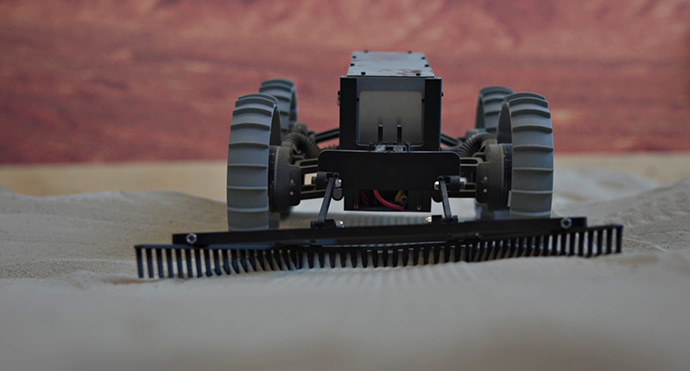Robots to pave the way for successful moon landings
25 March 2025
The Danish Technological Institute has developed a concept using autonomous, mobile robots that can eventually pave the way for safer moon landings.
Although humanity took its first steps in lunar dust over 50 years ago, ensuring a successful moon landing remains a challenging maneuver even today.
Beyond challenges with communication delays, temperature fluctuations, and lack of atmosphere, one of the riskiest aspects is the moon's uneven surface, which makes finding a safe landing site difficult.
But robots could become part of the solution in the future.
At their Space Robotics Lab, the Danish Technological Institute (DTI) is developing autonomous robots that can be sent ahead prior to a moon landing. These robots will be used to level the surface where a spacecraft can land.
− Robots will become a central element in exploring the moon – and the universe as a whole – but if we initially want to get humans back on the moon, it makes good sense to send terrain-navigating robots ahead. They can both prepare a landing site and explore what the terrain consists of before we send humans to the moon, says Kristian Skaarup, Director of Defence and Space Robotics at DTI.

− This will make it much safer for humans and reduce the costs of space missions, as a higher success rate for landings will be achieved, he adds.
Uneven surfaces can be fatal for landing vehicles, as recent attempts from India, Israel, and Japan have highlighted.
Robots designed for harsh environments
Technology not only opens new doors for space exploration. It can also have potential industrial applications on Earth.
− When technology needs to function in space with radiation, pressure, and extreme temperature fluctuations, it must be robust and reliable beyond the ordinary. You don't just send a service technician 384,405 kilometers away to reset and restart a robot. It has to work every time, says Kristian Skaarup, continuing:
− If the technology can achieve such a degree of robustness, it can also be used and provide benefits in harsh environments on Earth.
The development is supported by the Danish Agency for Education and Research under the Ministry of Higher Education and Science.
About the Space Robotics Lab
The Danish Technological Institute's Space Robotics Lab in Odense was inaugurated in 2024.
The new robot laboratory aims to meet the growing demand for robot technology for space and to further leverage Denmark's position of strength in robotics in this field.
DTI has already been part of developing a robotic arm for collecting soil and rock samples on Mars as part of the ESA contribution to the NASA-led Mars Sample Return mission, and the Institute is currently developing protective clothing – a so-called smart skin – for robotic arms, which will pave the way for more robots in space.